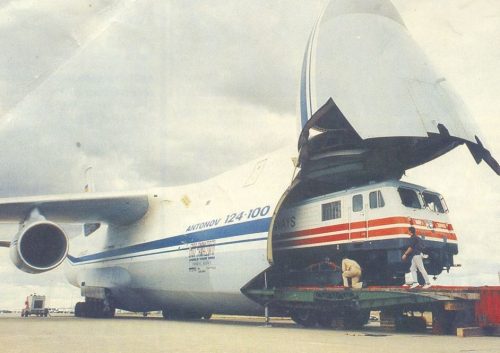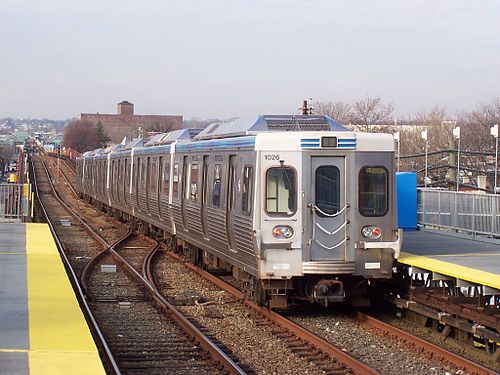The Alstom factory at Dandenong has a long history of building trams and trains for the Melbourne public transport system, through predecessors Bombardier, Adtranz, ABB and Commonwealth Engineering. However they have also built rollingstock for the overseas market, such as these two Indian Railways WAP5 electric locomotives that left Australia onboard an Antonov An-124 heavy lift jet.
In 1996 the Financial Review told the story of how this came to be.
If Need Be, Adtranz Trains Grow Wings
By Tony Thomas
21 October 1996It was a big air-freight parcel, but flying two locomotives to Switzerland ensured that Adtranz kept a deadline and its reputation for innovation.
When the Adtranz factory at Dandenong, near Melbourne, built the first two of 33 locomotive bodies for Indian Railways, it had a freight problem. The prototypes had to go to the prime contractor, Adtranz Switzerland, for electrical installation and testing, but the timing was tight.
The solution was for the general manager (manufacturing) at Dandenong, Don Osborne, to contact the freight company operating the Russian Antonov super-freighter that circles the globe in search of business. The Antonov, detoured from China, took on the 96-tonne load at Avalon Airport and was in Zurich in a few days, saving about seven weeks of sea-freight time. The bill was not exactly low, but it was only one-third more than sea freight.
This is the innovative style of Adtranz, which was formed in January by merging the transport arms of Asea Brown Boveri (Sweden) and Daimler-Benz (Germany). Twenty-eight of the 33 locomotives have been delivered, and Indian rail workers will soon get the technology transfer to make their own.
Dandenong wins Adtranz locomotive and train subcontracts through internal bidding because its design and labor costs are well below the European operation’s levels. Direct labor costs are about half the European rates, and productivity, although hard to compare, is satisfactory.
Most of the output is for export. Osborne says: “It is lumpy, with a long time between lumps for local work, but for the past three to four years the factory has had a fair degree of work stability.” Dandenong, bought from Comeng in 1990, is one of three Adtranz global factories building train carriages in stainless steel; its rivals are Adtranz Sweden and Adtranz Portugal. The criteria for winning work are price, delivery and workload. Osborne foresees Dandenong getting orders for carriages worldwide, in sets of hundreds valued up to $200 million.
The Dandenong factory has 190 shop-floor workers, including 16 apprentices. Because stainless-steel welding is not a common skill, tradesmen have to re-qualify to Adtranz standards. Computer-aided design is linked to laser cutters to cut the parts. “New processes usually need a bundle of new technologies and skills,” Osborne says. In the past few years demarcation has been reduced to produce the required flexibility.
Globally, the locomotive business has split into the European group of Siemens, Adtranz and GEC Alsthom, which have the edge in lightweight electric trains, and General Electric and General Motors in the US, the kings of the heavyweight diesel-electric category. Now there are cross-Atlantic alliances covering both diesel and electric models, including a technical agreement between Adtranz and GE for lightweight diesel-electric units.
Any client inquiry leads to Adtranz mobilising globally to work out the best way of winning the bid. The internal bidding process could cause one Adtranz unit to hoard expertise. “Initially, we found it hard to share our knowledge,” Osborne says. Adtranz dealt with the issue by setting up, and helping to fund, global centres of excellence in sub-systems such as propulsion, carriage bodies and bogies. “At Dandenong we focus on car-bodies for global markets and complete vehicles for the local market.”
After the first two locomotive bodies were air freighted to Switzerland onboard a Antonov An-124, the following units were able to leave Australia by the slower route by sea. After their final fitout in Switzerland, the finished locomotives were then moved by road to the Rhine, transported by barge for transit to Rotterdam, and then by cargo ship to Calcutta.
The WAP-5 electric passenger locomotives that went by air are still in service in India today.
Along with the WAG-9 electric freight locomotives that also had their body shells built at Dandenong.
Meanwhile in Philadelphia
Believe it or not, this is another train built in the 1990s by Adtranz at Dandenong – the M-4 subway cars used on the Market–Frankford Line in Philadelphia, Pennsylvania.
Again, the Financial Review has the back story behind the Australian connection.
Dandenong is supplying 222 carriage shells and bogie sets to the SEPTA for a subway and elevated rail system. The contract is valued at almost $100 million. The units are being shipped on top of sea containers for fitting out at Elmira, near New York, by Adtranz US. Eight prototypes are in final assembly there, and Dandenong has moved on to production versions for the next two years.
The standards are rigorous, including a 100-tonne compression test for buckling or distortion. Clients are also demanding extremely lightweight structures, compared with older designs. The penalties in the contract for excess weight are severe; equivalent to the lifetime extra energy cost per kilogram.
A SEPTA inspector from Pennsylvania is stationed at Dandenong to check product quality, which has improved practically with each new shell as output rises to 14 a month, using three shifts.
The roof and side-wall welding in the trains is being automated with a purpose-built machine made by Harris Engineering, Sydney. This will cut the welding time from almost five days to six hours. “It is not world-beating technology but it is a good solution,” Osborne says.
SEPTA has specified a 40-year guarantee of serviceability, which requires the factory workers to take a new perspective on quality and customer expectations. Bogie design must pass tests over an enormous six million cycles. In earlier years there was a cost-plus outlook and allowances for contingencies. The workers have met the challenge with new skills and more flexible work methods.
In practice, a train becomes obsolete because of patterns of use, not because of hardware. Operators chase improvements in comfort to woo people back to public transport. Osborne says: “For example, trains are replaced in favor of air-conditioned models long before the old ones wear out.”
Commissioning is a complex affair, including the measurement of various movements as the trains speed along the Pennsylvania tracks, to ensure clearances throughout the lines. Among the difficulties is that the US still uses imperial measurement, rather than metric, so components ordered from US makers need careful re-specification.
Footnote: some prophetic words
The 1996 Financial Review article also had some prophetic words given the decline in rollingstock manufacturing across Australia.
He is disappointed there is no industry-wide approach to rail vehicle supply in Australia. “Instead of the railways and suppliers sitting down and working on the best solutions for themselves and Australia, we fight over the same patch each time. The public tendering system is a major barrier to forming an efficient industry with export potential.” (The other large groups are Clyde Industries, taken over by Evans Deakin last July, and the Howard Smith subsidiary Goninan, which has been named preferred tenderer for a National Rail order for up to 120 locomotives.)
Osborne says: “In Europe, Adtranz is working jointly with its big rival Siemens on the 330-kilometre-per-hour ICE [intercity express] trains because the project can’t afford fragmented manufacture. Likewise, the Swedes and the Germans co-operate on tilt-train design. Adtranz, Siemens and Thyssen are working jointly on the Transrapid magnetic levitation train between Hamburg and Berlin, which has been operating for three years on test tracks and has a top speed of 500kmh. The industry in Australia ought to get together on a project like the next-generation Olympia class double-decker trains for the Sydney lines, create a brilliant train, then break into export markets with it.”
The world trend is for rail standardisation across borders. Australia has been one of the worst offenders on non-conformity, because each state’s rail engineers have tended to specify exclusive features. Osborne sees the first use by TNT of its own trains on government track from Sydney to Perth as the start of a new era in making rail freight more competitive.
Further reading
Indian railfan Sundar Mukherjee has covered the history of the WAP-5 and WAG-9 locomotives in his article “Indian Railways GP 140. Introduction of 3 Phase Locomotives in India. (The beginning of a new era)“.



The Bombardier metro trains in Guangzhou were delivered by air freight at the factory’s cost due to delayed production.
Bombardier trains built in Germany for the Delhi Metro were also moved by air in 2009.
https://www.gettyimages.com.au/detail/news-photo/germany-brandenburg-parchim-transport-of-the-first-news-photo/548140933
In a way, the V/Locity has been that “Brilliant train” that has been exported – at least domestically – from the Dandenong factory. That body keeps on sprouting up in various places.
The domestic interstate supply would be by rail, though.
In the case of broad gauge trains for Adelaide they were moved by truck from Dandenong, thanks to the break of gauge inbetween.